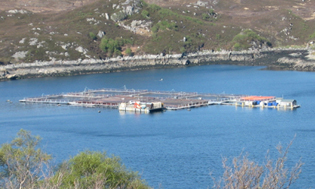Statement by Inland Fisheries Ireland
 Inland Fisheries Ireland notes the findings of a new international scientific paper which identifies fundamental flaws in the methodology and findings of a study (Jackson et al), elements of which have formed the basis of an EIS submitted in support of the proposed Galway Bay Salmon Farm.
Inland Fisheries Ireland notes the findings of a new international scientific paper which identifies fundamental flaws in the methodology and findings of a study (Jackson et al), elements of which have formed the basis of an EIS submitted in support of the proposed Galway Bay Salmon Farm.
The new paper demonstrates that the impact of sea lice on wild salmon causes a much higher loss (34%) of those returning to rivers in the west of Ireland, than the 1% loss suggested heretofore in the Jackson paper. The new study entitled “Comment on Jackson et al. “Impact of Lepeophtheirus salmonis infestations on migrating Atlantic salmon, Salmo salar L., smolts at eight locations in Ireland with an analysis of lice-induced marine mortality” is published by Krkošek, et al. (2013) in The Journal of Fish Diseases. It points out fundamental methodological errors made by Jackson et al. (2013). Following a re-analysis of the same data, it shows that it incorrectly concluded that sea lice play a minor, perhaps even negligible, role in salmon survival and that this finding emerged following three fundamental methodological errors.
This new paper conducts a re-analysis of the data with the findings departing substantially from those reported and interpreted by Jackson et al. (2013), and in previous publications that drew on some of the same data (Jackson, et al. 2011a; 2011b). Whereas Jackson et al. 2013 assert that sea lice cause 1% of mortality in Atlantic salmon, the correct estimate is actually a one third loss (34%) of overall returned stocks.
The new paper gives the example that if, in the absence of parasites, final adult salmon recruitment is 6% of smolt production, then the effect of parasite mortality reduces that recruitment to 4%. According to interpretations used by Jackson et al. (2013), that is a change of 2%. However, the overall effect is that it reduces the abundance of adult salmon returning to a river from, say, 6,000 down to 4,000; this 1/3 loss of salmon returns could have significant conservation or fishery implications. Krkošek, et al. 2013 emphasise that their purpose is not to downplay factors other than parasites that may also have a large influence on marine survival of Atlantic salmon. They do however highlight that parasites can and, in this case, clearly do have a large effect on fisheries recruitment, irrespective of apparent changes in overall marine mortality over time, and with important implications for the management and conservation of wild salmon stocks.
Two of the publications that utilise some of the same data (Jackson et al. 2011a & 2011b), and which contain the methodological errors reported above, have been referred to in the Environmental Impact Statement submitted by BIM in their proposal for a deep sea fish farm in Galway bay. In support of the contention that sea lice do not negatively impact on out migrating salmon smolts, the Marine Institute studies by Jackson et al. 2011a & 2011b are quoted as concluding that the infestation of outwardly migrating salmon smolts with sea lice was only a minor component of the overall marine mortality in the stocks studied. This contention may now be questioned by the re-analysis undertaken in this new paper by Krkošek, et al. 2013.
This paper concurs with previously published international research (Krkosek et al, 2012 & Gargan et al, 2012) which indicates that sea lice emanating from aquaculture facilities can cause significant mortality to Atlantic salmon. IFI welcomes the clarification in this new paper regarding the potential negative impact of sea lice emanating from marine salmon farms and looks forward to ensuring effective sea lice management to reduce or eliminate this impact. In this context, the location of salmon farms in relation to salmon rivers and the control of sea lice prior to and during juvenile salmon migration to their high seas feeding ground is critical if wild salmon stocks are not to be impacted. The development of resistance to chemical treatment of sea lice and other fish husbandry problems, such as pancreas disease and amoebic gill disease, are likely to make effective sea lice control even more difficult in future years.
IFI is supportive of the development of a sustainable aquaculture industry and welcome all advances in research that will underpin the sustainability of this industry and safeguard wild salmon and sea trout stocks into the future.
Read More:
Inland Fisheries Ireland Website
